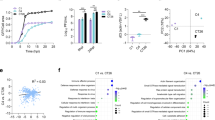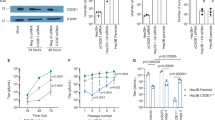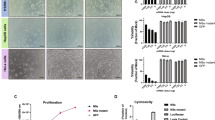Abstract
Cancer stem cells (CSCs), also termed “cancer-initiating cells” or “cancer progenitor cells,” which have the ability to self-renew, proliferate, and maintain the neoplastic clone, have recently been discovered in a wide variety of pediatric tumors. These CSCs are thought to be responsible for tumorigenesis and tumor maintenance, aggressiveness, and recurrence due to inherent resistance to current treatment modalities such as chemotherapy and radiation. Oncolytic virotherapy offers a novel, targeted approach for eradicating pediatric CSCs using mechanisms of cell killing that differ from conventional therapies. Moreover, oncolytic viruses have the ability to target specific features of CSCs such as cell-surface proteins, transcription factors, and the CSC microenvironment. Through genetic engineering, a wide variety of foreign genes may be expressed by oncolytic viruses to augment the oncolytic effect. We review the current data regarding the ability of several types of oncolytic viruses (herpes simplex virus-1, adenovirus, reovirus, Seneca Valley virus, vaccinia virus, Newcastle disease virus, myxoma virus, vesicular stomatitis virus) to target and kill both CSCs and tumor cells in pediatric tumors. We highlight advantages and limitations of each virus and potential ways in which next-generation engineered viruses may target resilient CSCs.
Similar content being viewed by others
Log in or create a free account to read this content
Gain free access to this article, as well as selected content from this journal and more on nature.com
or
References
Ries LAG, Melbert D, Krapcho M, et al. SEER Cancer Statistics Review, 1975–2005. Bethesda, MD: National Cancer Institute. (http://seer.cancer.gov/csr/1975_2005/,2008.)
Friedman GK, Gillespie GY . Cancer Stem Cells and Pediatric Solid Tumors. Cancers (Basel) 2011;3:298–318.
Sneddon JB, Werb Z . Location, location, location: the cancer stem cell niche. Cell Stem Cell 2007;1:607–11.
Das B, Tsuchida R, Malkin D, Koren G, Baruchel S, Yeger H . Hypoxia enhances tumor stemness by increasing the invasive and tumorigenic side population fraction. Stem Cells 2008;26:1818–30.
Moore SW . Developmental genes and cancer in children. Pediatr Blood Cancer 2009;52:755–60.
Vlashi E, McBride WH, Pajonk F . Radiation responses of cancer stem cells. J Cell Biochem 2009;108:339–42.
Rich JN, Bao S . Chemotherapy and cancer stem cells. Cell Stem Cell 2007;1:353–5.
Yang ZJ, Wechsler-Reya RJ . Hit ‘em where they live: targeting the cancer stem cell niche. Cancer Cell 2007;11:3–5.
Hammill AM, Conner J, Cripe TP . Oncolytic virotherapy reaches adolescence. Pediatr Blood Cancer 2010;55:1253–63.
Lacroix J, Witt O, Sclehofer JR, Rommelaere J . Therapeutic exploitation of oncolytic viruses in pediatric oncology. Drugs Fut 2010;35:1015.
Friedman GK, Pressey JG, Reddy AT, Markert JM, Gillespie GY . Herpes simplex virus oncolytic therapy for pediatric malignancies. Mol Ther 2009;17:1125–35.
Chou J, Kern ER, Whitley RJ, Roizman B . Mapping of herpes simplex virus-1 neurovirulence to gamma 134.5, a gene nonessential for growth in culture. Science 1990;250:1262–6.
Singh SK, Clarke ID, Terasaki M, et al. Identification of a cancer stem cell in human brain tumors. Cancer Res 2003;63:5821–8.
Hemmati HD, Nakano I, Lazareff JA, et al. Cancerous stem cells can arise from pediatric brain tumors. Proc Natl Acad Sci USA 2003;100:15178–83.
Taylor MD, Poppleton H, Fuller C, et al. Radial glia cells are candidate stem cells of ependymoma. Cancer Cell 2005;8:323–35.
Chiou SH, Kao CL, Chen YW, et al. Identification of CD133-positive radioresistant cells in atypical teratoid/rhabdoid tumor. PLoS ONE 2008;3:e2090.
Mahller YY, Williams JP, Baird WH, et al. Neuroblastoma cell lines contain pluripotent tumor initiating cells that are susceptible to a targeted oncolytic virus. PLoS ONE 2009;4:e4235.
Markert JM, Medlock MD, Rabkin SD, et al. Conditionally replicating herpes simplex virus mutant, G207 for the treatment of malignant glioma: results of a phase I trial. Gene Ther 2000;7:867–74.
Rampling R, Cruickshank G, Papanastassiou V, et al. Toxicity evaluation of replication-competent herpes simplex virus (ICP 34.5 null mutant 1716) in patients with recurrent malignant glioma. Gene Ther 2000;7:859–66.
Hunter WD, Martuza RL, Feigenbaum F, et al. Attenuated, replication-competent herpes simplex virus type 1 mutant G207: safety evaluation of intracerebral injection in nonhuman primates. J Virol 1999;73:6319–26.
Radbill AE, Reddy AT, Markert JM, et al. Effects of G207, a conditionally replication-competent oncolytic herpes simplex virus, on the developing mammalian brain. J Neurovirol 2007;13:118–29.
Markert JM, Coen DM, Malick A, Mineta T, Martuza RL . Expanded spectrum of viral therapy in the treatment of nervous system tumors. J Neurosurg 1992;77:590–4.
Friedman GK, Langford CP, Coleman JM, et al. Engineered herpes simplex viruses efficiently infect and kill CD133+ human glioma xenograft cells that express CD111. J Neurooncol 2009;95:199–209.
Lasner TM, Kesari S, Brown SM, Lee VM, Fraser NW, Trojanowski JQ . Therapy of a murine model of pediatric brain tumors using a herpes simplex virus type-1 ICP34.5 mutant and demonstration of viral replication within the CNS. J Neuropathol Exp Neurol 1996;55:1259–69.
Parikh NS, Currier MA, Mahller YY, et al. Oncolytic herpes simplex virus mutants are more efficacious than wild-type adenovirus Type 5 for the treatment of high-risk neuroblastomas in preclinical models. Pediatr Blood Cancer 2005;44:469–78.
Kambara H, Okano H, Chiocca EA, Saeki Y . An oncolytic HSV-1 mutant expressing ICP34.5 under control of a nestin promoter increases survival of animals even when symptomatic from a brain tumor. Cancer Res 2005;65:2832–9.
Mahller YY, Vaikunth SS, Ripberger MC, et al. Tissue inhibitor of metalloproteinase-3 via oncolytic herpesvirus inhibits tumor growth and vascular progenitors. Cancer Res 2008;68:1170–9.
Zhu G, Su W, Jin G, et al. Glioma stem cells targeted by oncolytic virus carrying endostatin-angiostatin fusion gene and the expression of its exogenous gene in vitro. Brain Res 2011;1390:59–69.
Dmitrieva N, Yu L, Viapiano M, et al. Chondroitinase ABC I-mediated enhancement of oncolytic virus spread and antitumor efficacy. Clin Cancer Res 2011;17:1362–72.
Hu JC, Coffin RS, Davis CJ, et al. A phase I study of OncoVEXGM-CSF, a second-generation oncolytic herpes simplex virus expressing granulocyte macrophage colony-stimulating factor. Clin Cancer Res 2006;12:6737–47.
Fong Y, Kim T, Bhargava A, et al. A herpes oncolytic virus can be delivered via the vasculature to produce biologic changes in human colorectal cancer. Mol Ther 2009;17:389–94.
Harrington KJ, Hingorani M, Tanay MA, et al. Phase I/II study of oncolytic HSV GM-CSF in combination with radiotherapy and cisplatin in untreated stage III/IV squamous cell cancer of the head and neck. Clin Cancer Res 2010;16:4005–15.
Bharatan NS, Currier MA, Cripe TP . Differential susceptibility of pediatric sarcoma cells to oncolysis by conditionally replication-competent herpes simplex viruses. J Pediatr Hematol Oncol 2002;24:447–53.
Ribacka C, Hemminki A . Virotherapy as an approach against cancer stem cells. Curr Gene Ther 2008;8:88–96.
Short JJ, Curiel DT . Oncolytic adenoviruses targeted to cancer stem cells. Mol Cancer Ther 2009;8:2096–102.
Persson A, Fan X, Salford LG, Widegren B, Englund E . Neuroblastomas and medulloblastomas exhibit more Coxsackie adenovirus receptor expression than gliomas and other brain tumors. Neuropathology 2007;27:233–6.
Rice AM, Currier MA, Adams LC, et al. Ewing sarcoma family of tumors express adenovirus receptors and are susceptible to adenovirus-mediated oncolysis. J Pediatr Hematol Oncol 2002;24:527–33.
Sasaki T, Tazawa H, Hasei J, et al. Preclinical evaluation of telomerase-specific oncolytic virotherapy for human bone and soft tissue sarcomas. Clin Cancer Res 2011;17:1828–38.
Xu Y, He K, Goldkorn A . Telomerase targeted therapy in cancer and cancer stem cells. Clin Adv Hematol Oncol 2011;9:442–55.
Geoerger B, van Beusechem VW, Opolon P, et al. Expression of p53, or targeting towards EGFR, enhances the oncolytic potency of conditionally replicative adenovirus against neuroblastoma. J Gene Med 2005;7:584–94.
Pesonen S, Helin H, Nokisalmi P, et al. Oncolytic adenovirus treatment of a patient with refractory neuroblastoma. Acta Oncol 2010;49:117–9.
García-Castro J, Alemany R, Cascalló M, et al. Treatment of metastatic neuroblastoma with systemic oncolytic virotherapy delivered by autologous mesenchymal stem cells: an exploratory study. Cancer Gene Ther 2010;17:476–83.
Rizzo MT . Cyclooxygenase-2 in oncogenesis. Clin Chim Acta 2011;412:671–87.
Jiang H, Gomez-Manzano C, Aoki H, et al. Examination of the therapeutic potential of Delta-24-RGD in brain tumor stem cells: role of autophagic cell death. J Natl Cancer Inst 2007;99:1410–4.
Nandi S, Ulasov IV, Tyler MA, et al. Low-dose radiation enhances survivin-mediated virotherapy against malignant glioma stem cells. Cancer Res 2008;68:5778–84.
Van Houdt WJ, Haviv YS, Lu B, et al. The human survivin promoter: a novel transcriptional targeting strategy for treatment of glioma. J Neurosurg 2006;104:583–92.
Zhang JG, Kruse CA, Driggers L, et al. Tumor antigen precursor protein profiles of adult and pediatric brain tumors identify potential targets for immunotherapy. J Neurooncol 2008;88:65–76.
Preusser M, Wolfsberger S, Czech T, Slavc I, Budka H, Hainfellner JA . Survivin expression in intracranial ependymomas and its correlation with tumor cell proliferation and patient outcome. Am J Clin Pathol 2005;124:543–9.
Adida C, Berrebi D, Peuchmaur M, Reyes-Mugica M, Altieri DC . Anti-apoptosis gene, survivin, and prognosis of neuroblastoma. Lancet 1998;351:882–3.
Fangusaro JR, Jiang Y, Holloway MP, et al. Survivin, Survivin-2B, and Survivin-deItaEx3 expression in medulloblastoma: biologic markers of tumour morphology and clinical outcome. Br J Cancer 2005;92:359–65.
Skog J, Edlund K, Bergenheim AT, Wadell G . Adenoviruses 16 and CV23 efficiently transduce human low-passage brain tumor and cancer stem cells. Mol Ther 2007;15:2140–5.
Strong JE, Coffey MC, Tang D, Sabinin P, Lee PW . The molecular basis of viral oncolysis: usurpation of the Ras signaling pathway by reovirus. Embo J 1998;17:3351–62.
Quinlan MP, Quatela SE, Philips MR, Settleman J . Activated Kras, but not Hras or Nras, may initiate tumors of endodermal origin via stem cell expansion. Mol Cell Biol 2008;28:2659–74.
Yang WQ, Senger D, Muzik H, et al. Reovirus prolongs survival and reduces the frequency of spinal and leptomeningeal metastases from medulloblastoma. Cancer Res 2003;63:3162–72.
Hingorani P, Zhang W, Lin J, Liu L, Guha C, Kolb EA . Systemic administration of reovirus (Reolysin) inhibits growth of human sarcoma xenografts. Cancer 2011;117:1764–74.
Marcato P, Dean CA, Giacomantonio CA, Lee PW . Oncolytic reovirus effectively targets breast cancer stem cells. Mol Ther 2009;17:972–9.
Reddy PS, Burroughs KD, Hales LM, et al. Seneca Valley virus, a systemically deliverable oncolytic picornavirus, and the treatment of neuroendocrine cancers. J Natl Cancer Inst 2007;99:1623–33.
Yu L, Baxter PA, Zhao X, et al. A single intravenous injection of oncolytic picornavirus SVV-001 eliminates medulloblastomas in primary tumor-based orthotopic xenograft mouse models. Neuro-oncology 2011;13:14–27.
Rudin CM, Poirier JT, Senzer NN, et al. Phase I clinical study of Seneca Valley Virus (SVV-001), a replication-competent picornavirus, in advanced solid tumors with neuroendocrine features. Clin Cancer Res 2011;17:888–95.
Wadhwa L, Hurwitz MY, Chévez-Barrios P, Hurwitz RL . Treatment of invasive retinoblastoma in a murine model using an oncolytic picornavirus. Cancer Res 2007;67:10653–6.
Morton CL, Houghton PJ, Kolb EA, et al. Initial testing of the replication competent Seneca Valley virus (NTX-010) by the pediatric preclinical testing program. Pediatr Blood Cancer 2010;55:295–303.
McCart JA, Ward JM, Lee J, et al. Systemic cancer therapy with a tumor-selective vaccinia virus mutant lacking thymidine kinase and vaccinia growth factor genes. Cancer Res 2001;61:8751–7.
Kirn DH, Wang Y, Le Boeuf F, Bell J, Thorne SH . Targeting of interferon-beta to produce a specific, multi-mechanistic oncolytic vaccinia virus. PLoS Med 2007;4:e353.
Guse K, Cerullo V, Hemminki A . Oncolytic vaccinia virus for the treatment of cancer. Expert Opin Biol Ther 2011;11:595–608.
Wojton J, Kaur B . Impact of tumor microenvironment on oncolytic viral therapy. Cytokine Growth Factor Rev 2010;21:127–34.
Lun X, Chan J, Zhou H, et al. Efficacy and safety/toxicity study of recombinant vaccinia virus JX-594 in two immunocompetent animal models of glioma. Mol Ther 2010;18:1927–36.
Contag CH, Sikorski R, Negrin RS, et al. Definition of an enhanced immune cell therapy in mice that can target stem-like lymphoma cells. Cancer Res 2010;70:9837–45.
Mansour M, Palese P, Zamarin D . Oncolytic specificity of Newcastle disease virus is mediated by selectivity for apoptosis-resistant cells. J Virol 2011;85:6015–23.
Ravindra PV, Tiwari AK, Sharma B, Chauhan RS . Newcastle disease virus as an oncolytic agent. Indian J Med Res 2009;130:507–13.
Reichard KW, Lorence RM, Cascino CJ, et al. Newcastle disease virus selectively kills human tumor cells. J Surg Res 1992;52:448–53.
Lorence RM, Reichard KW, Katubig BB, et al. Complete regression of human neuroblastoma xenografts in athymic mice after local Newcastle disease virus therapy. J Natl Cancer Inst 1994;86:1228–33.
Csatary LK, Gosztonyi G, Szeberenyi J, et al. MTH-68/H oncolytic viral treatment in human high-grade gliomas. J Neurooncol 2004;67:83–93.
Freeman AI, Zakay-Rones Z, Gomori JM, et al. Phase I/II trial of intravenous NDV-HUJ oncolytic virus in recurrent glioblastoma multiforme. Mol Ther 2006;13:221–8.
Wagner S, Csatary CM, Gosztonyi G, et al. Combined treatment of pediatric high-grade glioma with the oncolytic viral strain MTH-68/H and oral valproic acid. APMIS 2006;114:731–43.
Wang G, Barrett JW, Stanford M, et al. Infection of human cancer cells with myxoma virus requires Akt activation via interaction with a viral ankyrin-repeat host range factor. Proc Natl Acad Sci USA 2006;103:4640–5.
Hambardzumyan D, Becher OJ, Rosenblum MK, Pandolfi PP, Manova-Todorova K, Holland EC . PI3K pathway regulates survival of cancer stem cells residing in the perivascular niche following radiation in medulloblastoma in vivo. Genes Dev 2008;22:436–48.
Eyler CE, Foo WC, LaFiura KM, McLendon RE, Hjelmeland AB, Rich JN . Brain cancer stem cells display preferential sensitivity to Akt inhibition. Stem Cells 2008;26:3027–36.
Wu Y, Lun X, Zhou H, et al. Oncolytic efficacy of recombinant vesicular stomatitis virus and myxoma virus in experimental models of rhabdoid tumors. Clin Cancer Res 2008;14:1218–27.
Cripe TP, Wang PY, Marcato P, Mahller YY, Lee PW . Targeting cancer-initiating cells with oncolytic viruses. Mol Ther 2009;17:1677–82.
Kim M, Madlambayan GJ, Rahman MM, et al. Myxoma virus targets primary human leukemic stem and progenitor cells while sparing normal hematopoietic stem and progenitor cells. Leukemia 2009;23:2313–7.
Stojdl DF, Lichty B, Knowles S, et al. Exploiting tumor-specific defects in the interferon pathway with a previously unknown oncolytic virus. Nat Med 2000;6:821–5.
Lun X, Senger DL, Alain T, et al. Effects of intravenously administered recombinant vesicular stomatitis virus (VSV(deltaM51)) on multifocal and invasive gliomas. J Natl Cancer Inst 2006;98:1546–57.
Paglino JC, van den Pol AN . Vesicular stomatitis virus has extensive oncolytic activity against human sarcomas: rare resistance is overcome by blocking interferon pathways. J Virol 2011;85:9346–58.
Yasmeen A, Zhang L, Al Moustafa AE . Does the vesicular stomatitis virus really have a selective oncolytic effect in human cancer? Int J Cancer 2010;126:2509–10.
Toyoda H, Wimmer E, Cello J . Oncolytic poliovirus therapy and immunization with poliovirus-infected cell lysate induces potent antitumor immunity against neuroblastoma in vivo. Int J Oncol 2011;38:81–7.
Studebaker AW, Kreofsky CR, Pierson CR, Russell SJ, Galanis E, Raffel C . Treatment of medulloblastoma with a modified measles virus. Neuro-oncology 2010;12:1034–42.
Lacroix J, Leuchs B, Li J, et al. Parvovirus H1 selectively induces cytotoxic effects on human neuroblastoma cells. Int J Cancer 2010;127:1230–9.
Kumar S, Gao L, Yeagy B, Reid T . Virus combinations and chemotherapy for the treatment of human cancers. Curr Opin Mol Ther 2008;10:371–9.
Touchefeu Y, Vassaux G, Harrington KJ . Oncolytic viruses in radiation oncology. Radiother Oncol 2011;99:262–70.
Nguyen TL, Tumilasci VF, Singhroy D, Arguello M, Hiscott J . The emergence of combinatorial strategies in the development of RNA oncolytic virus therapies. Cell Microbiol 2009;11:889–97.
Author information
Authors and Affiliations
Corresponding author
Rights and permissions
About this article
Cite this article
Friedman, G., Cassady, K., Beierle, E. et al. Targeting pediatric cancer stem cells with oncolytic virotherapy. Pediatr Res 71, 500–510 (2012). https://doi.org/10.1038/pr.2011.58
Received:
Accepted:
Published:
Issue date:
DOI: https://doi.org/10.1038/pr.2011.58
This article is cited by
-
Tumor Microenvironment: A Niche for Cancer Stem Cell Immunotherapy
Stem Cell Reviews and Reports (2024)
-
The role of oncolytic virotherapy and viral oncogenes in the cancer stem cells: a review of virus in cancer stem cells
Cancer Cell International (2023)
-
Advances and potential pitfalls of oncolytic viruses expressing immunomodulatory transgene therapy for malignant gliomas
Cell Death & Disease (2020)
-
N-Myc expression enhances the oncolytic effects of vesicular stomatitis virus in human neuroblastoma cells
Molecular Therapy - Oncolytics (2016)
-
Cancer stem cell markers in pediatric sarcomas: Sox2 is associated with tumorigenicity in immunodeficient mice
Tumor Biology (2016)



